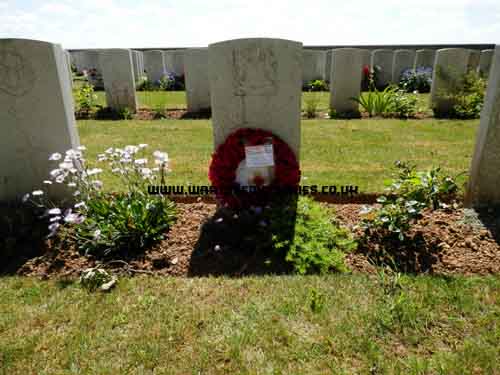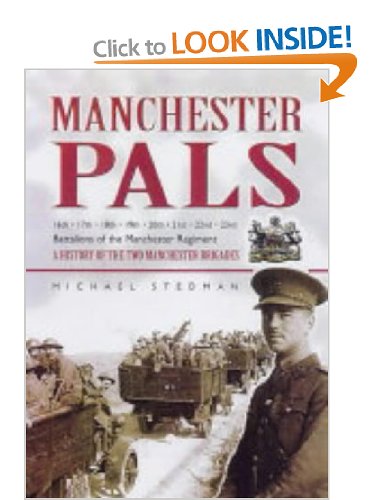|
|
|
22nd (7th City) Battalion, Manchester Regiment
The 22nd (7th City) Battalion, Manchester Regiment was raised in Manchester on the 21st of November 1914 by the Lord Mayor and City. They moved to Morecambe for training in January 1915 and in April joined 91st Brigade, 30th Division at Grantham. They moved to Larkhill, Salisbury Plain for final training in September 1915 and proceeded to France in early November, landing at Boulogne. On the 20th of December 1915 91st Brigade transferred to 7th Division. In 1916 They were in action during the Battles of the Somme, including the capture Mametz, The Battle of Bazentin, the attacks on High Wood, The Battle of Delville Wood, The Battle of Guillemont and the Operations on the Ancre. In 1917 They fought during The German retreat to the Hindenburg Line and the flanking operations round Bullecourt during The Arras Offensive, before moving to Flanders for the Third Battle of Ypres, seeing action in The Battle of Polygon Wood, The Battle of Broodseinde, The Battle of Poelcapelle and The Second Battle of Passchendaele. In late 1917 the 7th Division was selected to move to Italy. They took up position in the line along the River Piave,in late January 1918. The Division played a central role in crossing the Piave, in October and the Battle of Vittoria Veneto.
16th Oct 1915 The Derby Scheme
1st Dec 1915 Derby Scheme Armlets
11th Sep 1915 Last day of Derby Scheme Recruitment
10th Jan 1916 Group System Reopens
31st January 1916 In trenches.
1st February 1916 Battalion reliefs
9th February 1916 Call Ups
17th Jun 1916 Letter Home
1st Mar 1917 On the March
2nd Mar 1917 Working Party
3rd Mar 1917 Working Parties
5th Mar 1917 Casualties
6th Mar 1917 On the March
8th Mar 1917 Posting
12th Mar 1917 On the March 
13th Mar 1917 On the March
14th Mar 1917 In Action
15th Mar 1917 Into Billets
17th Mar 1917 Into Billets
18th Mar 1917 Change of Billets
19th Mar 1917 In Billets
21st Mar 1917 In Billets
22nd Mar 1917 In Billets
23rd Mar 1917 Change of Billets
25th Mar 1917 Into Camp
27th Mar 1917 Reliefs
28th Mar 1917 Wire Entanglements
29th Mar 1917 Reliefs
31st Mar 1917 Change of Billets
4th Oct 1917 In Action 
7th Oct 1917 Reliefs Complete 
If you can provide any additional information, please add it here.
|
| Want to know more about 22nd (7th City) Battalion, Manchester Regiment ? There are:5261 items tagged 22nd (7th City) Battalion, Manchester Regiment available in our Library There are:5261 items tagged 22nd (7th City) Battalion, Manchester Regiment available in our Library 
These include information on officers, regimental histories, letters, diary entries, personal accounts and information about actions during the Great War.
|
|
Those known to have served with22nd (7th City) Battalion, Manchester Regiment during the Great War 1914-1918. - Baker Percy Robert. Pte.
- Berridge Harold Sydney. Pte
- Bleasdale Samuel Mason. L/Cpl. (d.1st Jul 1916)
- Bone Sydney. Pte. (d.20th Feb 1920 )
- Bunting A.. Pte. (d.13th Dec 1918)
- Chesney Joseph. Pte. (d.29th Feb 1916)
- Connolly George Christopher. Pte. (d.7th June 1916)
- Craggs George Martin. Pte.
- Craggs George Martin. Pte.
- Daley Edward. Pte. (d.13th May 1917)
- Davenport Joseph. Pte.
- Garside Robert Taylor. CQMS
- Garside Robert Taylor.
- Heath Arthur. Cpl. (d.1st Jul 1916)
- Icke Ernest William. L/Cpl. (d.1st July 1916)
- Johnson Percy. Drmr. (d.12th Dec 1916)
- Jones Samuel S.. L/Cpl. (d.5th Oct 1917)
- Lamb Joseph. Cpl.
- Maloney Austin Martin. Pte. (d.13 May 1917)
- Murray Michael Francis. Pte. (d.28th Mar 1917)
- Pavey Frederick. Pte. (d.1st July 1916)
- Potts Edwin. Pte.
- Rowbottom Tom Prescott. Pte. (d.4th October 1917)
- Smale Frank. Pte. (d.23 Aug 1918)
- Smith William. Pte. (d.29th March 1917)
- Taylor John Robert. Pte.
- Townson Henry. Pte. (d.1st July 1916)
- Vince Stanley Gilbert Gordon. Cpl.
- Whitfield Robert. Pte.
- Wolstencroft MM. Edward. L/Cpl. (d.14th Mar 1917)
All names on this list have been submitted by relatives, friends, neighbours and others who wish to remember them, if you have any names to add or any recollections or photos of those listed,
please Add a Name to this List
Records of 22nd (7th City) Battalion, Manchester Regiment from other sources.
|
|
The Wartime Memories Project is the original WW1 and WW2 commemoration website.

- 1st of September 2024 marks 25 years since the launch of the Wartime Memories Project. Thanks to everyone who has supported us over this time.
|
Want to find out more about your relative's service? Want to know what life was like during the Great War? Our
Library contains many many diary entries, personal letters and other documents, most transcribed into plain text.
|
Looking for help with Family History Research?
Please see Family History FAQ's
Please note: We are unable to provide individual research.
|
|
Can you help?
The free to access section of The Wartime Memories Project website is run by volunteers and funded by donations from our visitors.
If the information here has been helpful or you have enjoyed reaching the stories please conside making a donation, no matter how small, would be much appreciated, annually we need to raise enough funds to pay for our web hosting or this site will vanish from the web.
If you enjoy this site
please consider making a donation.
Announcements
- 19th Nov 2024
Please note we currently have a massive backlog of submitted material, our volunteers are working through this as quickly as possible and all names, stories and photos will be added to the site. If you have already submitted a story to the site and your UID reference number is higher than
264989 your submission is still in the queue, please do not resubmit.
Wanted: Digital copies of Group photographs, Scrapbooks, Autograph books, photo albums, newspaper clippings, letters, postcards and ephemera relating to the Great War. If you have any unwanted
photographs, documents or items from the First or Second World War, please do not destroy them. The Wartime Memories Project will give them a good home and ensure that they are used for educational purposes. Please get in touch for the postal address, do not sent them to our PO Box as packages are not accepted.
|
World War 1 One ww1 wwII greatwar great battalion regiment artillery
Did you know? We also have a section on World War Two. and a
Timecapsule to preserve stories from other conflicts for future generations.
|
|
|
Pte. Percy Robert Baker 22nd Btn. Manchester Regiment Percy Baker was 18 years and 5 months when he enlisted on the 10th of May 1916. He was too young for active service overseas and appears to be one of a group of young men who enlisted under the extended Derby scheme.
He was posted to the Royal Field Artillery when mobilised on the 8th of October 1916 and was compulsorily transferred to the infantry on the 25th of November 1916. On the same date he was sent to the 49th Training Reserve Battalion from there he was posted to the BEF and joined 22nd Manchester Regiment.
He went on to serve with the Battalion in Italy.
|
Pte. John Robert Taylor 22nd (7th City) Btn. Manchester Regiment John Taylor served with the 22nd Manchester Regiment, the 7th Manchester Pals.
|
Pte. Sydney Bone 22nd (7th City) Battalion, B Coy, 5th Plt. Manchester Regiment (d.20th Feb 1920 ) Sydney Bone died in Manchester of blood poisoning caused by bullet wound on 1st of July 1916.
His last years spent in a home in Manchester in a wheelchair as he could not walk due to a spine injury.
|
Drmr. Percy Johnson 22nd Btn. Manchester Regiment (d.12th Dec 1916) Percy Johnson was my great uncle and a bugler in the Great War.
I have a small autograph-type book which contains several poems written by Percy after he enlisted in 1915, some of which were written at the front.
Percy was killed in action a year after enlisting and is buried at Redan Ridge Cemetery No.1, near Beaumont-Hamel.
|
Pte. George Christopher Connolly 22nd (7th City) Battalion Manchester Regiment (d.7th June 1916) George Connolly served with the 7th Manchester Pals.
|
Pte. Edward Daley 22nd Battalion Manchester Regiment (d.13th May 1917) Edward Daley was killed in action, age 25. He is commemorated in honour on the Arras memorial in France.
|
Pte. Michael Francis Murray 22nd Btn. Manchester Regiment (d.28th Mar 1917) Michael Murray is my grandfather. He was killed in action in 1917 and is buried in British War Graves Cemetery in Croiselle, Northern France.
Unfortunately, although I have searched several WW1 records, I have been unable to find copy of his service record.
|
Pte. Joseph Davenport 22nd Battalion Manchester Regiment According to Joseph Davenport's Medal Rolls Index Card and other documents, he enlisted on July 19, 1915 into the 22nd Battalion, Manchester Regiment
He entered the French theatre on 11th of November 1915 and thereby qualified for the 1914-15 Star. At some point during his service, he was transferred to the Labour Corps. Per the Manchester Regiment's Medal Roll for the 1914-15 Star, Private Davenport was discharged on 13th of November 1917. This date is corroborated by a Roll of Individuals Entitled to the War Badge, although his first name is listed as James, he is correctly identified by his Labour Corps service number, 32051. The number of his Silver War Badge is listed as 306479. In addition to the 1914-15 Star and the Silver War Badge, he was awarded the British War Medal and Victory Medal. Searches for either his Service Record or Pension Record via ancestry.com resources were unsuccessful, it is possible that these records were among those destroyed during the Second World War.
|
Pte. A. Bunting 22nd (7th City) Btn. Manchester Regiment (d.13th Dec 1918) Private Bunting was the Son of Charles Bunting, of Manchester; husband of Effie Bunting (nee Young) of 19 Shakespeare St., Ardwick, Manchester.
He was 33 when he died and is buried in the Vittener Cemetery in Lithuania.
|
Pte. Edwin Potts 22nd Battalion Manchester Regiment My Great Grandfather, Edwin Potts, was married to Mary Alice Hopkinson. The following story is from memories written down by my Great Aunt Ethel Delany, one of Edwin's 7 children. There is nothing about his time in the army, but probably like many returned servicemen, he didn't talk about them, especially to the younger children.
Edwin was a cabinet maker & was in partnership with his brother in a small factory. They sold furniture from their shop, where they also sold crockery, gramophones, records, hardware etc.
Unfortunately one year after returning from the War, Edwin accidentally fell off a tram and died a week later. He was 40.
Three years later his wife emigrated to New Zealand, where some of Edwin's sisters had already settled. with the 7 children on the ship, Ruahine. They settled in Nelson.
|
Robert Taylor Garside 22nd Btn. Manchester Regiment Robert Garside served with the 22nd Manchesters, his brother Paul with 2nd Btn Royal Berkshire Regiment. Their father was Thomas Douglas Hamilton Garside, political speaker & journalist, co-author with James Myles Hogge MP of the book War Pensions And Allowances published 1918.
|
Pte. Frederick Pavey 22nd Battalion Manchester Regiment (d.1st July 1916) Private Frederick Pavey was my great uncle who died on the first day of the Battle of the Somme, along with countless others in his battalion. He was 20 years old.
|
Pte. George Martin Craggs 22nd Btn. C Coy Manchester Regiment George Craggs served with C Coy 22nd Btn. Manchester Regiment.
|
Pte. Henry Townson 22nd Battalion Manchester Regiment (d.1st July 1916) In the 1911 Census Henry Townson is recorded as a Police Constable living in Manchester with his wife Alice (nee Bradshaw) and two daughters. He was born in Garstang and they had married at Lancaster in 1906.
He had previously served in the Scots Guards in the Boer War. He was killed in the assault on Bucket Trench on the first day of the Battle of the Somme.
The Commonwealth Graves Commission reports he died on the first day of the Battle of the Somme when the 22nd Battalion is part of the 7th Divison attacking Mametz. The CWGC reports that his widow had moved to Morecambe at the time of his death, her home town.
|
Cpl. Joseph Lamb 22nd Btn. B Coy. 8Plt. Manchester Regiment Joseph Lamb was a stoker at Stuart St power station immediately prior to WW1 though he had previously worked in a cotton mill.
On the 1st of September 1914 he attested with the 12th Btn. Kings Royal Rifle Corps as a private No 531, but this was short lived as he was discharged 1 month later under Kings Regulation 392, 111 (unlikely to become an efficient soldier).
Evidently, not put off by this hitch, he then joined the 22nd Manchester Regiment, "B" Company, VII Platoon as a Private on the th of January 1915. His initial training took place at Stretford Rd Barracks, Hulme, Manchester. During this period the 22nd Manchester's had no billets, uniforms or weaponry and in fact returned home at the end of each day's training. The Battalion then moved to Morecambe followed by Grantham and then Larkhill Camp, Salisbury Plain.
They were then sent to France via Folkestone to Boulogne. Due to appalling weather they were billeted overnight until the sea calmed down though the sailing could not be described as calm. The battn then continued advanced training before tasting their first "active service" in trenches facing Thiepval (at that point a heavily defended German stronghold) under the watchful eye of the 1st Bttn Hampshire Regt.
The 22nds remained in France and were billeted at Fricourt the night before the opening of The Battle of the Somme. On the opening of the battle they held trenches midway between Fricourt and Mametz and went over the top in an attempt to capture/liberate the German held village of Mametz. The objective was achieved and proved to be one of the few successes of the day which saw 60,000 allied casualties.
The 22nds lost officers killed May, Bland, Mellor, Gomersall, Peak, Brunt, Swan, Nansen, Price and Gill. Officers Wounded:
Lloyd, Worthington Prince, Cotton, Wood, >Workhouse and Riley wounded. 120 other ranks were killed and 241 others were wounded or missing.
In late September Joseph Lamb was listed as wounded on The Times daily casualty lists though I can find no detail of the nature of the wound. They remained in the Somme region and took part in the Battle of Bullecourt in May 1917. This battle proved to be another fiasco largely due to the failure of British tanks to reach, let alone disrupt the enemy front line. My other grandfather was captured during this battle.
The Battalion moved to Belgium in September 1917 to take part in the 3rd battle of Ypres (Paschaendale). On the 2nd of October 1917 Joe Lamb was in dugouts in a railway embankment west of Zillebeke Lake. On the night of the 3rd the Battlion marched up to Polygon Wood in preparation for the Battle of Broodseinde Ridge. The Manchester's attacked Broodseinde Ridge early on the 4th and he was hit by a shell and lay injured in a shell hole. A German soldier was in the same shell hole and managed to dress Joe's badly wounded leg. Upon the arrival of other British troops Joe Lamb managed to talk them out of shooting the German soldier who was subsequently taken as a POW.
Joe Lamb was evacuated to Britain and spent some time at Colchester Military Hospital though by this time he had lost a leg 2 inches above the knee. He received further treatment at the 2nd Western Military Hospital on Whitworth St, Manchester. It was here on 1st of July 1918 that his artificial leg was "successfully fitted".
He later returned to work for the Electricity Dept as a storeman. He was never a well man after the war and died aged 47 in 1943. His brother in law (another Manchester Pal) died in the same hospital on the same day with neither widow (sisters) realising the other was there.
During his recuperation Joe took offence to a grocery boy's taunts aimed at the injured soldiers. When the boy entered the hospital Joe, regardless of his missing leg stole and hid the boys delivery bike. Try explaining that to your boss!
|
L/Cpl. Samuel S. Jones 22nd Btn Manchester Regiment (d.5th Oct 1917) My great granddad Samuel Jones fought and was wounded at Gallipoli and evacuated. He was sent to France where he suffered trench fever. He returned to France and died of wounds on the 5th October 1917, received in the fighting at Broodseinde Ridge (part of the Battle of Passchendaele) on 4th October 1917.
|
L/Cpl. Edward Wolstencroft MM. 22nd Battalion, C Company, XII Platoon Manchester Regiment (d.14th Mar 1917)  Edward Wolstencroft was born on Tuesday 10th December 1895 in Bradford, East Manchester, son to Edward Wolstencroft and Sarah Ann (previously Hynes). He was the fourth oldest of ten children, seven girls and 3 boys, Mary, Sarah Ann, Ellen, Margaret, Esther, Christopher, William, Cecilia and Winifred. Living at 15 Loftus Street, Bradford until he was two years of age, he was baptised on 1st January 1896 at Brigids Roman Catholic Church, Bradford, Manchester.
Edward being single lived with his family at various addresses in Bradford, Manchester. In the 1911 Census, he was living at 3 Moody St, Bradford with his parents and working as a labourer in an Iron Foundary. During 1911 - 1914 the family moved to 14 Lime Street, which was to be Edwards last home. He appears to have been employed at Ashburys Carriage Co. He probably began is employment here as Ashbury Railway Carriage and Iron Company was based in Openshaw and provided railway carriage, wagon and tram cars, therefore could have been classed as an iron foundary in 1911. He was also a member of St Brigids Social Club.
The First World War broke out in August 1914 and Edward joined the 7th City Battalion just after 4th December, though as his records were bombed in WWII, the exact date in not know. The City Battalions were 'Pals' units, formed by the workers of Manchester so that they could serve together. He was given the service number 21070. This unit became the 22nd Battalion of the Manchester Regiment and Edward was assigned to XII Platoon in C Company. His Platoon Commander was Orric Knudsen, whose medals at in the Museum of the Manchester Regiment collection in the Town Hall, Ashton Under Lyne.
The 22nd Battalion moved to Heaton Park in Manchester, then to Morecambe on the Lancashire coast in December 1914, and then to Belton Park near Grantham in Lincolnshire during April 1915. Next month they were at Larkhill in Wiltshire. They were based here until the 11th November when they sailed to France.
We don't know much about Edward's time in France. The 22nd Battalion served around Mametz near Fricourt during early 1916. They took part in the Somme Offensive which began on the 1st July, and attacked Mametz on the first day. They then served on the Somme until the Offensive ended in November, and fought in the Battle of Arras just after Edwards death during April 1917.
The Manchester Evening News reported "Honours for Local Heroes" on 10th August 1916 informing us that he had been awarded the Military Medal. His citation was in the London Gazette on 8th August 1916, supplement 29701, page 7891.
Shortly after the end of the war the National Publishing Company began an attempt to print a roll covering every man who had served in the First World War. They invited veterans or their families to send a short account of his or her service, for a fee. Not all veterans took up this offer, and the details they included were not checked for accuracy. Presumably Edward's parents sent this biography to the Company. It was published in Manchester, page 412 of the National Roll of the Great War:
"After volunteering in December 1914, he was drafted to the Western Front, where he played a prominent part in the Battles of the Somme and other battles."
Ellen Rowan, Edwards younger sister told family stories saying that her brother was wounded, returned home and then returned to fight, only to be shot by a sniper where he fell and died. She always said he was buried in the Poppy Fields, which was true. Edward is listed in the Military's full casualty list as being wounded 24th June 1916, however there is no more information.
During the early nineties, Carol Baguley (nee Lowe), Edwards great niece was researching the family tree, when she came across the Commonwealth War Graves Commission web site, it was here that the journey into his life and bravery began.
Carol then visited his niece Joan (Edwards sister Cecilia's daughter) and was given information regarding his bravery and shown his 1914-15 Star medal with a photograph that the family presumed was Edward. After many months of searching, the article in the Manchester Evening news was found, which had the same photograph that the family had kept all these years.
Edward was not only awarded the 1915-15 Star but also Military Medal for conspicuous bravery in the field, the British War Medal and the Victory Medal.
On 14th March 1917 the 21st and 22nd Battalions of the Manchester Regiment fought to take Bucquoy, it was probably during this action that Edward was killed. On that day the 22nd Battalion had almost 150 casualties either killed or wounded.
A letter was sent to Edward & Sara Wolstencroft on 6th April 1921 as below;
"I am directed to transmit to you the accompanying British War Medal and Victory Medal which would have been conferred upon No 21070 Pte E Wolstencroft, Manchester Regiment had he lived, in memory of his services with the British Forces during the Great War.
"In forwarding the Decoration I am commanded by the King to assure you of His Majesty's high appreciation of the services rendered."
Edward & Sarah then received another letter dated 14th April 1917 to inform them of their sons death with a form stating as below;
"Edward Wolstencroft 22nd Batallion died 14/03/1917, killed in Action. Theatre of War: France and Flanders. MM, Rank: L/CPL No: 21070."
|
Cpl. Arthur Heath 22nd Battalion Manchester Regiment (d.1st Jul 1916) 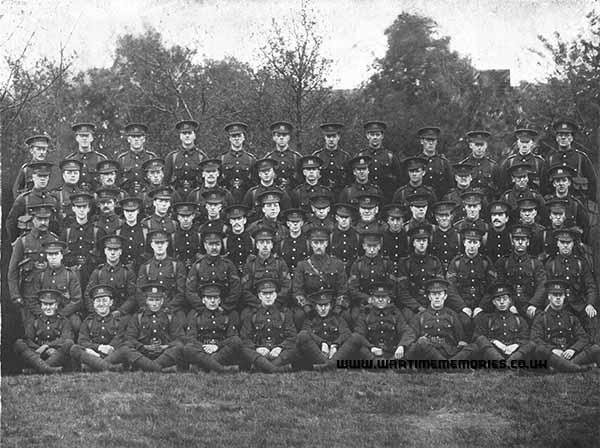 Arthur Heath was my grandfather, he joined up in November 1914 when his one & only son Arthur was just 1 month old. He joined one of the Pals Battalions that was raised by the Lord Mayor of Manchester. He was in C Company, Platoon XII. A photograph with his platoon is attached, along with the list of names of those shown. Arthur is my Grand Father & when he died on the first day of the Battle of the Somme he left behind not just his son, but a widow & two daughters, one of which was my Mother. He has no known grave, but is commemorated on the Thiepval Memorial in France. His civilian life entailed working as a barman at the time of his marriage to Emily in 1904. He also worked as a bar steward for Manchester Liners & one of the ships he sailed on was the Manchester Importer. Just before he volunteered to join the Army he was working for the Charles MacIntosh Rubber Works in Manchester. It would be nice to hear from anybody who's Grand Father is also pictured in the attached Platoon Photograph & named in the second attachment. Arthur was killed on the first day of the Battle of the Somme with the Manchester Pals. He has no known grave & his name is on the Thiepval Monument. He left behind a wife, two daughters, one of which was my mother, & a very young son who was born after he enlisted in 1914. My Mother had just started school when she received at least two letters from him. One of which he sent his kind regards to her schoolteacher & hoped that he would get to meet her when he came home. The family do not know if this ever took place as we are not sure if he ever got leave before he was killed? We are aware that he was very proud to have a son who was named after him. Unfortunately Arthur Heath Junior died when he was eight, so my Grandmother had a double tragedy to deal with.
Arthur's mother, Mary Ellen Huddart, married Charles Frederick Heath on the 05/06/1887 when Arthur was 6 years old. It is not known who Arthur's biological father was. Charles Frederick appears to have taken the boy as his own as according to the 1891 census the 10 year old Arthur is stated as the son of Charles Frederick.
In 1904 Arthur married Emily Carter, a widow, & they had 3 children, one of which was my Mother.
Before volunteering for the Manchester Pals 7th City 22nd Battalion, Arthur was working for a shipping company operating out of the Manchester Ship Canal.
His son, Arthur Frederick, was born on the 23rd October 1914, a matter of weeks before his father, Arthur Heath, volunteered as part of a recruitment drive by the then Lord Mayor of Manchester.
The family assumed that his baby son was born after Arthur volunteered. We will never know why a man of 33 years would volunteer, leaving behind a new born son & two young daughters. We can only assume, like thousands of others, he truly believed the propaganda, that it would all be over by Christmas. 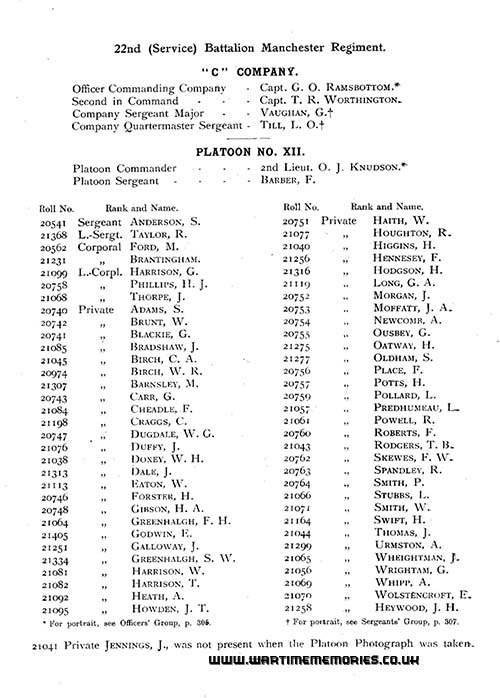 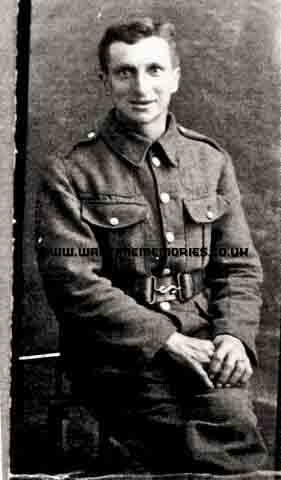 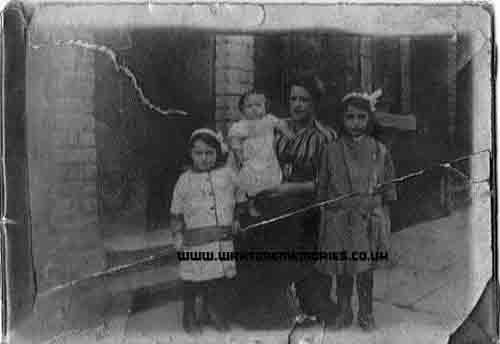
|
CQMS Robert Taylor Garside 22nd (7th City) Btn. Manchester Regiment Robert Taylor Garside was the younger son of Emma M Goldman who married Thomas Douglas Hamilton Garside in 1884 in Philadelphia USA. Robert was younger brother of Paul Hamilton Douglas Garside (aka 'Peter Hammond').
Robert Taylor Garside married Mary Palmer in in Lower Broughton 1914 and had two sons, Ronald & Roy Garside.
Robert enlisted on the 2nd of Sep 1914 aged 24 and gave his birth place as Lower Broughton, occup. Clerk, address 17 Grecian St Lower Broughton. He was actually born in USA c.1891 (see UK census 1901).
He was posted to 19th Manchesters (4th City) Battalion.
On the 19th of Jan 1915 he was posted to 22nd Manchesters (7th City) 'B' Coy Platoon V. and was promoted same day to CQMS. Robert was apparently a 1st class shot. In the regimental photo he is sitting on the right of his CO Capt. Alfred Bland.
On the 11th of Nov 1915 the battalion was posted to France.
On the 1st of Jul 1916 (first day of The Somme) the 22nd Manchesters were part of the 7th Division at Mametz. Robert was wounded in France & operated on at Endell St Military Hospital then sent to Kings Lancashire Convalescent Hospital, Clifton Park on 15 Jan 1918.
On the 19th of Feb 1918 he was posted to the 3rd Manchesters and on the 17th of Feb 1919 Robert was discharged to classZ from the 8th Reserve Battalion.
Robert Taylor Garside died in 1947 in Fylde Lancashire.
|
Pte. Robert Whitfield 22nd Btn. Manchester Regiment My Grandfather was Robert Whitfield. I know he served in the British Army during WW1. I was told by my Auntie when she was alive that he served in Belgium. I am researching Family History and would love to know a bit more about what he was actually doing over there. Robert survived WW1 and went on to be a Junior School Deputy Headmaster in the Greater Manchester area.
|
Recomended Reading.Available at discounted prices.
|
The Manchester Pals Martin Steadman
Manchester proved able to raise eight Pals battalions. Initially, these battalions were composed of middle-class men who experience before the war years was within the commercial, financial and manufacturing interests which formed the foundations of Edwardian Manchester's life and prosperity. Manchester was undeniably proud of its pals battalions; that the area was capable of raising. Seven months after their arrival in France the battle of the Somme was launched, on the fateful 1st July, 1916. On the right of the British Army's extraordinary efforts that day, the Manchester Pals were part of one of the few successful actions, taking the villages of Montauban and Mametz and making a deep incursion into the German defences north of the River Somme.
|
|
|






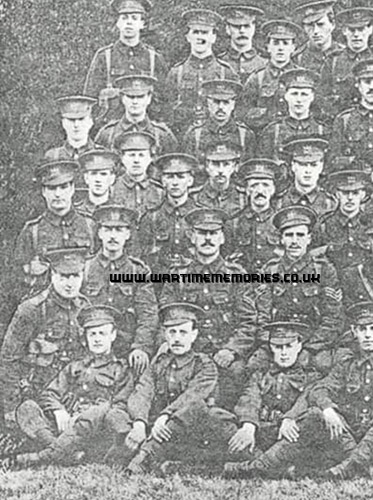

.jpg)


